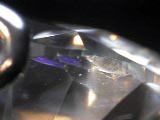elmo
Brilliant_Rock
- Joined
- Jun 18, 2003
- Messages
- 1,160
Interesting - let''s say a fracture reached the surface but extended well into the stone. The bleaching occurs both on the surface and inside the stone as a result. Not as a result of laser drilling. Would the GIA report this or not?Date: 7/5/2007 8:47:08 PM
Author: CaptAubrey
Acid boiling + surface-reaching inclusion as a result of faceting = bleached inclusion = no treatment, no disclosure









300x240.png)